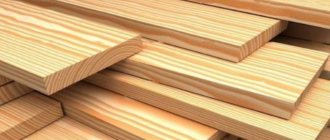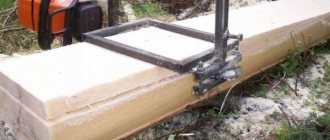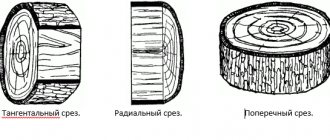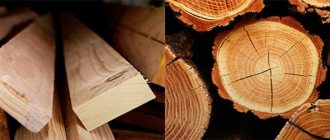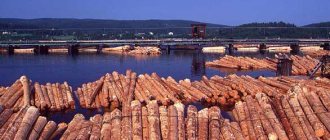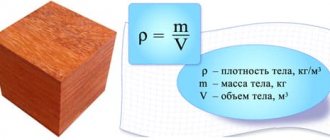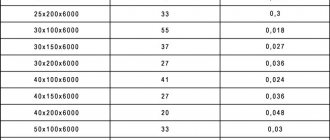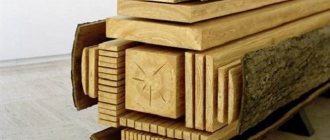Wood color and texture
Pine, larch, oak, etc. are distinguished by the pronounced color of the core part;
spruce, birch, linden, etc. do not have this color. The color of wood changes over time under the influence of physical and chemical factors. For example, a freshly cut alder tree in a short period of time in the air changes from light pink to yellowish-red. This color change occurs as a result of oxidation (under the influence of air and light on the wood) of the coloring substance found in the cells of alder wood. When exposed to a solution of iron salts, wood of some species (oak, chestnut) darkens because it contains tannin. Abnormal wood color, dark or colored spots or streaks are a sign of fungal growth. Coniferous wood has a generally simple and uniform texture (pattern), while deciduous wood has a more complex texture. Wood species such as oak, ash, chestnut, walnut, pine, larch, yew, etc., give a beautiful texture when cut in a tangential manner; maple, beech, plane tree, etc. give a beautiful texture in a radial section. Due to the richness and variety of wood textures, a number of species are highly valued for carpentry and finishing work.
Processing methods
To improve a number of performance indicators, lumber is subjected to primary and finishing processing. Staining is practically not used when working with oak, but is used for cheaper types of wood. When drying oak, try to avoid accelerating the process, as this leads to the appearance of defects.
The main methods of processing finished oak products and semi-finished products:
- atmospheric and chamber drying in gentle temperature conditions;
- staining – gives a darker color and highlights a beautiful oak structure;
- varnish coating – often used after staining to consolidate the visual effect;
- impregnation with oils – used for individual decorative elements.
The video will tell you how to bleach oak wood:
How wood behaves under compression
The strength of wood is influenced by humidity, shape and size of samples, wood defects, etc. Characteristics of the mechanical properties of wood are determined by testing clean (defect-free) samples of standard sizes. When testing, the moisture content of the wood samples must be taken into account.
Wood compression resistance
The compressive strength of wood is used in various parts of structures (piles, columns, racks, supports, struts and other elements of wooden trusses).
Depending on the direction of the force in relation to the direction of the wood fibers, they are distinguished
- a) compression along the fibers;
- b) compression across the fibers in the radial direction;
- c) compression across the fibers in the tangential direction.
Compression: a - along the fibers; b - across the fibers in the radial direction, c - across the fibers in the tangential direction
In addition to the indicated types of forces, there may also be those whose direction makes an acute or obtuse angle with the direction of the wood fibers. When a wood sample is compressed along the grain, fracture lines are found on its side surfaces; on the radial surface they look like horizontal lines, and on the tangential surface they look like inclined lines, their angle is usually slightly greater than 45° (Fig. 2)
Rice. 2. The nature of destruction of a wood sample under compression along the fibers.
As observations and studies under a microscope show, when compressed along the fibers of a wood sample, even before the appearance of fracture lines visible to the naked eye, changes occur in the cell walls. These changes appear in the tracheids of coniferous species in the form of thin, clearly defined lines running at a certain angle to the longitudinal axis of the fiber.
Humidity has a great influence on the deformability and strength of wood.
With increasing humidity, the deformability of wood increases and its strength decreases compared to dry wood, which is especially noticeable during static bending and compression. This effect manifests itself with changes in humidity ranging from 0 to the fiber saturation point. At higher humidity values (on average over 30%), the strength of the wood remains almost constant.
The cell membrane (wall) consists of elementary fibers that form a complex structural network. The spaces between the mesh fibers are filled with a hydrophilic elastic colloidal substance. When wood dries, it becomes stronger and resists external forces, like an elastic body, together with a network of elastic elementary fibers. In a wet state, the colloidal substance passes into a plastic state and then only the swollen mesh provides resistance to external forces.
Mechanical properties of wood
Indicators of the mechanical properties of wood are usually determined using the following types of tests: tension, compression, bending and shear. Since wood is an anisotropic material, i.e. material with different properties in different directions, indicate the direction of load action: along or across the fibers (in the radial or tangential direction). Due to the resistance of wood to external loads, internal forces arise in it. These forces per unit cross-sectional area (1 cm2) are called stresses. The maximum stress preceding the destruction of a body is called the tensile strength. The tensile strength is determined on small, clean and defect-free samples in laboratories using testing machines. These samples have a base section with dimensions of 20 * 20 mm and must include at least 4-5 annual layers. Some types of tests are carried out on samples whose cross-section differs from the specified one. They are determined on samples of prismatic shape. The use of wood as a structural material is due to its ability to resist forces, i.e. mechanical properties.
The general trend is that the denser the wood, the more strength it has. The density and strength of wood increases if the forest grows in elevated areas and sandy soils.
Increasing humidity to the limit of hygroscopicity (up to 30%) reduces the mechanical properties of wood. Drying wood by 1% (within the range of humidity changes from 20 to 8%) increases its resistance to compression and bending by 4%, and tensile strength by 1%.
Wood defects reduce its strength. Due to the presence of defects, the strength of a beam or board cannot be assessed based on the results of testing small clean samples. Therefore, unlike other materials, timber grades are determined not by the strength of the samples, but on the basis of an assessment of the nature, size and number of defects.
The following properties of wood are distinguished, manifested under the influence of mechanical loads: strength - the ability to resist destruction, deformability - the ability to resist changes in size and shape, technological and operational properties.
Strength depends on humidity - as humidity increases, it decreases. The strength of wood is affected only by changes in the amount of hygroscopic moisture. When humidity increases above the saturation point of the fibers, the strength of wood practically does not decrease.
Wood, due to its fibrous structure, has high tensile and compressive strength along the grain and much less strength across the grain. In coniferous trees, the compressive strength along the fibers is 10-12 times greater than across them, and in hardwoods it is 5-8 times greater. The mechanical strength of wood largely depends on its bulk density; As the volumetric mass of wood increases, strength increases. The strength of wood is characterized by its tensile strength, i.e. stress equal to the ratio of the greatest load preceding the destruction of the sample to its original cross-sectional area. The deformation of wood can be different not only depending on the magnitude of the acting forces, but also on the duration of their influence. Thus, under short-term exposure to a certain force, the deformation can be elastic, and under long-term exposure to the same force, it can be residual, and the longer the exposure, the greater the deformation.
In many wooden structures, wood works in compression, crushing, chipping, bending, and less often in tension, both along and across the fibers. In this regard, wood is tested mainly for compression along and across the grain, for chipping and bending.
Strength of wood when compressed along the grain. This is one of the important mechanical properties of wood. The compressive strength along the fibers is significant and varies among different rocks from 40 to 60 MPa at a standard humidity of 12% and from 20 to 40 MPa at a humidity above 30%. The compression of wood along the grain is important when using it for furniture, piles, posts, roof trusses, etc.
The strength of wood when compressed across the grain. When wood is compressed across the fibers, depending on the species and direction of compression (radial, tangential), the deformation can be uniform - single-phase and uneven - three-phase. In the latter case, during testing, an increase in stress and deformation is initially observed (phase), then the increase in stress almost stops and only an increase in the deformation of the sample is observed (phase), then the stresses begin to increase (phase). Due to the presence of phase-by-phase deformation, compression tests across the fibers are carried out with registration of both forces and deformation values. The conditional compressive strength across the fibers is taken to be the stress corresponding to the limit of proportionality, i.e. the maximum voltage value in a straight section of the diagram. The conditional limit is 6-10 times less than for compression along the fibers.
Tensile strength along the grain. When wood is stretched along the fibers, the strength indicator has the greatest values. The tensile deformation of wood (elongation of the sample) is insignificant. Destruction occurs in the form of tissue rupture. At high strength, the gap is long-fiber, and at low strength it is conchoidal, almost smooth. The tensile strength of wood along the grain depends on the type of wood and is in the range of 70-170 MPa at a humidity of 12%. An increase in humidity leads to a slight decrease in strength. The tensile strength is determined by the formula a = Pmax/bh. Here b and h are the width and thickness of the working part of the sample, cm; Pmax is the maximum load preceding the failure of the sample; N.
Tensile strength across the grain. Wood has relatively little resistance to stretching across the grain. The value of the tensile strength along the fibre, if there are cracks, this value can generally drop to zero. Therefore, in practice, wood is not used for tensile work across the grain. Determining the tensile strength of wood across the grain is necessary to develop drying modes that are safe with respect to cracking and to justify cutting modes.
Strength of wood under static bending. When wood bends, tensile stresses arise on the convex side and compressive stresses on the concave side. In addition, shear stresses arise when shearing along the fibers. Wood's resistance to static bending is of great importance in many structures made from it - furniture, skis, beams, rafters, bridges. The tensile strength of wood during static bending, depending on the species, ranges from 70-150 MPa (at a humidity of 12%). An increase in humidity leads to a decrease in tensile strength to 40-90 MPa (at a humidity of 30% and above). Ultimate strength when loading the sample at the center o12 = ЗР ax/2bh2. Here is the distance between the centers of the supports, cm; b—width of the sample, cm; h is the height of the sample (in the direction of the force), cm.
Shear strength of wood. During shear, two equal and opposite forces act on wood. Many designs of furniture units, bridges, and trusses operate in shear. During shear, tangential forces act, located in a plane parallel to the action of external forces.
Shear testing is possible in three directions: shearing along the grain, shearing across the grain, cutting wood across the grain. Each type of test can be carried out in the radial and tangential directions. A total of six shear test cases are possible. The most common test is the shear test along the grain. The tensile strength when shearing along the fibers for softwood almost does not depend on the radial or tangential direction and is 6.5-10 MPa. In hardwood, with radial chipping, the tensile strength, depending on the species, is in the range of 6-16 MPa, with tangential chipping it is 10-30% higher than with radial chipping. The strength of wood under other shear conditions has been little studied.
Impact strength of wood. During static bending, a certain load is applied to the wood, the magnitude of which either remains constant or increases gradually. However, in some cases, the bending load can act more sharply: when ski jumping from a springboard, a large load on a bridge or chair, or a ship hitting a pier. Here it is important to know about the behavior and strength of wood. The load during impact bending is carried out on a special testing machine - a pendulum pile driver
Deformability
Under short-term loads, predominantly elastic deformations occur in wood, which disappear after the load. Up to a certain limit, the relationship between stress and strain is close to linear (Hooke's law). The main indicator of deformability is the coefficient of proportionality - the elastic modulus. The elastic modulus along the fibers is E = 12-16 GPa, which is 20 times greater than across the fibers. The higher the elastic modulus, the stiffer the wood. With an increase in the content of bound water and the temperature of the wood, its rigidity decreases. In loaded wood, when drying or cooling, part of the elastic deformations is converted into “frozen” residual deformations. They disappear when heated or moistened. Since wood consists mainly of polymers with long, flexible chain molecules, its deformability depends on the duration of exposure to loads. The mechanical properties of wood, like other polymers, are studied on the basis of the general science of rheology. This science examines the general laws of deformation of materials under the influence of load, taking into account the time factor.
Anisotropy of wood is characterized by its unequal resistance to forces in different directions in relation to the fibers
Defects are the shortcomings of individual sections of wood that reduce its quality and limit its use.
Defects are defects of mechanical origin that occur in wood during harvesting, transportation, sorting, stacking and processing.
Wood is a heterogeneous material, having various deviations from the norm and damage. Anything that significantly reduces the quality of wood - irregularity of its structure, damage, various diseases - is called defects. Unlike other building materials, the grade of wood is determined not only by the strength indicators, but mainly on the basis of a careful assessment of the defects present in it. The more accurately the defects are taken into account when sorting wood, the higher its use, but the more difficult the process of sorting, especially mechanized sorting. Since defects have a great influence on the mechanical properties of wood, test samples are prepared from wood that does not have defects. The influence of defects on the degree of suitability of wood for construction purposes depends on their type, location, size of the lesion, as well as the nature and purpose of the assortment, since the same defect is unacceptable in some assortments, but in others it only lowers the grade or does not matter at all. Therefore, each standard for wood grading has instructions on acceptable defects, on the basis of which timber is assessed and sorted depending on its purpose.
3. Actions of the employee in case of detection of a fire. Primary fire extinguishing agents.
If a fire is detected, you must:
- immediately report this to the fire service (and clearly state the address of the institution, the location of the fire, your position and surname, and also report the presence of people in the building);
— activate the fire warning system;
— take measures to evacuate people;
- notify the head of the enterprise or his replacement about the fire;
— organize a meeting of fire departments;
- begin to extinguish the fire using available means.
In the event of a fire, heads of departments, facilities and other officials are obliged to:
— check whether the fire has been reported to the fire service;
— organize the evacuation of people, take measures to prevent panic among those present;
— allocate the required number of people to ensure control and escort of evacuees;
— organize fire extinguishing using available means;
— send personnel who are well aware of the location of access roads and water sources to organize a meeting and escort fire service units to the fire site;
— remove from the danger zone all workers and other persons not involved in evacuating people and extinguishing the fire;
— stop all work not related to the evacuation of people and fire suppression;
— organize shutdowns of electricity and gas supply networks, technological equipment, ventilation and air conditioning systems;
— ensure the safety of people taking part in evacuation and fire suppression from possible structural collapses, exposure to elevated temperatures, toxic combustion products, electric shock, etc.;
— organize the evacuation of material assets from the danger zone, determine their storage locations and ensure their protection.
Wood tensile strength. Tensile strength of wood
Wood has high tensile strength along the grain and very low tensile strength across the grain.
The resistance of wood to tension along the fibers is characterized by a large variability of strength indicators (from 500 to 2000 kg/cm2), depending mainly on the structure of the wood, the length of the fibers, the angle of inclination of the fibers relative to the direction of the acting force, etc. The strength is also influenced by the chemical wood composition with increased lignin content, tensile strength decreases.
In structural elements, the strength depends on the presence of local weakening of the working section that appears during wood processing, on the influence of wood defects, etc. As a result, according to the standards and technical conditions, the main permissible tensile stress along the fibers for pine wood is only 70-85 kg/ cm2.
Tension in structures rarely occurs, mainly in the rafters.
To determine the tensile strength of wood along the grain, a standard sample is used, the shape and dimensions of which are shown in Fig.
Shapes and dimensions of the tensile specimen
The tensile strength of wood in the direction perpendicular to the fibers is only 2 - 5% of the tensile strength along the fibers in conifers. When stretched across the grain, the strength decreases due to the very weak bond (adhesion) between the wood fibers in the transverse direction.
Wood moisture content has no noticeable effect on tensile strength
Wood bending tests
Wood has a high resistance to bending and therefore is widely used in critical bendable parts of structures (beams, rafters, bridge beams, etc.). However, the resistance of wood to bending has a greater range of fluctuations than the resistance to compression along the fibers, due to more complex phenomena that occur during bending .
The bending resistance of wood depends on the same factors as the compression resistance, i.e. from humidity of volumetric weight, etc.
The presence of knots in wood, as well as the oblique arrangement of fibers and annual layers can significantly reduce the strength of wood (by 30% or more). With a change in the size of the sample, a change in the relative strength coefficient is also observed during compression, tension, chipping, etc.
Failure of wood samples under static transverse bending (in the case of applying a load in the middle): 1 - in the compressed zone due to the formation of folds, 2 - from shear stresses in the presence of small hidden cracks; 3 - simple tear, typical of straight-layered wood; 4 - oblique break, due to the oblique direction of the fibers 5 - blunt fracture characteristic of brittle wood; 6 - radiant fracture, characteristic of viscous wood.
Shear stresses in wood
Resistance of wood to chipping along the grain, chipping across the grain, and cutting.
Depending on the plane along which external forces act on the sample, they are distinguished:
- a) shearing along the fibers, when external forces, acting parallel to the fibers, tend to move one part of them relative to the other (along the length of the fibers);
- b) chipping across the fibers, when external forces directed perpendicular to the fibers tend to move one part of them relative to another in a plane parallel to the fibers;
- c) cutting, when external forces, also directed perpendicular to the fibers, tend to cut the latter perpendicular to their length.
Shearing: 1 - shearing along the fibers; 2 - chipping across the fibers; 3 - cutting across the fibers.
When chipping along and across the fibers, the strength of the wood fibers themselves is not compromised, but only their adhesion to each other is disrupted. Therefore, the shear resistance is significantly less than the shear resistance. Shearing stresses along the fibers occur quite often in wood, for example, in the joints of wooden elements.
Shear stresses across the grain are experienced by wooden transverse dowels in composite (along the height) wooden beams; shear stresses along the fibers - wooden rafters; cutting - plate dowels - planks made of oak or beech, used in beams that are composite in cross-sectional height. The resistance of wood to chipping along the grain is generally low and amounts to 15-25% of the resistance to compression in the same direction. The resistance to shearing across the grain is 30-80% of the resistance to shearing along the grain. The resistance to cutting is much higher (3-4 times) than the resistance to shearing along the fibers, but in practice it is extremely difficult to obtain a clean cut, since in this case the fibers are crushed and bent under the action of transverse compressive load.
Nail and screw retention, wood strength
The resistance to pulling out nails and screws, as established by experiments, depends on the friction force, hardness and elasticity of the wood, as well as on the direction of the fibers, i.e., on whether the nail is driven into the end or into the side surface of the board or beam.
The ability of wood to firmly hold nails, screws, spikes, staples, etc. is well known and widely used. The nail, entering the wood, moves apart like a wedge and partially cuts its fibers. The separated pieces of wood exert pressure on the side of the nail, which causes friction to hold the nail in place. The holding power of a nail or screw is measured by the maximum force (in kilograms) required to pull it out.
To increase friction, and therefore for greater bonding strength of the elements being connected, screws or wood grouse are used instead of nails. Hard rocks have a higher resistance to nail pullout than loose, soft rocks.
It is much easier to drive a nail into wet wood, but when it dries, the nail is easier to pull out, since the friction of the fibers in contact with the surface of the nail is reduced. The resistance to pulling out a nail driven into the end of the wood is 25-50% less (depending on the type of wood) than the resistance to pulling out a nail driven into the side surface (radial or tangential).
Strength of wood under long-term loads
This strength is characterized by the so-called long-term resistance limit, which is understood as the maximum stress that does not cause destruction for any duration of the load. For the first time, the definition of the limit of long-term resistance as the beginning of continuous deformations leading to destruction was given by F. P. Belyankin, who studied the deformations of wood under long-term load.
The experiments of F.P. Belyankin established that wooden blocks under a constantly acting and non-increasing bending load at stresses below the tensile strength determined by the standard method were destroyed after a more or less long period.
The value of the long-term resistance limit for the main building wood species has been established. On average, it is 0.5-0.6 of the tensile strength determined by conventional laboratory tests.
Wood hardness
Hardness is the ability of wood to resist the penetration of harder bodies, as well as cutting tools, nails and screws.
Since wood is cut in three ways, the hardness of the wood varies in these cutting directions.
The following types of hardness are distinguished according to the cutting directions:
— end (transverse);
- radial;
— tangential.
End (cross) cut - the tree is sawed perpendicular to the trunk and the direction of the grain.
End cutting of wood
Radial cutting is carried out along the trunk, along the radius, that is, through the center of the tree.
Radial cutting of wood
Tangential cutting is also performed longitudinally, but it passes outside the center, along the chord of the circle, and therefore peculiar patterns of growth rings are formed on the front surface of the cut.
Tangential cutting of wood
The hardness index of timber varies depending on the type of cut.
The lateral hardness of coniferous species is most often 40% lower than the end hardness, and for deciduous species it is 30% lower. The tangential hardness of, for example, oak, beech or elm timber is almost 10% higher than the end hardness. Most types of wood have approximately the same tangential and radial hardness.
According to the degree of hardness, all types of wood are divided into the following classes:
- hard as bone : ebony wood, coconut;
- very hard : oak, beech, white acacia, hornbeam, yew, rosewood;
- hard : oak, apple, pear, cherry, ash, teak;
- moderately hard - walnut, black pine, elm;
- soft : birch, linden, larch, alder, mahogany;
— very soft : spruce, white pine, poplar, willow, aspen, fir;
Hardwood is usually found in deciduous trees with broad, flat leaves that fall in autumn or spring, such as oak leaves. Because hardwood is also denser than softwood, its products are strong and durable, making it more valuable in carpentry.
Softwoods are primarily evergreen conifers that reproduce by cones. Since such trees grow faster, this wood is cheaper than solid wood. Soft wood is used in construction for the manufacture of beams, in furniture production, and is a raw material for the manufacture of paper.
But it is always necessary to remember that some deciduous trees actually have “softer” wood than coniferous trees.

